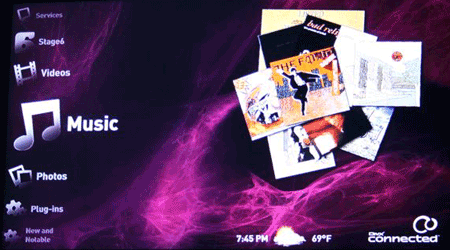 DivX has officially unveiled its “Connected” media extender platform. Previously codenamed “GejBox”, the device is designed to deliver content from a PC onto the living room television — entering a crowded market that includes the AppleTV, Playstation 3, XBox 360, as well as dozens of streaming media boxes from companies such as Netgear and Cisco, some of which already license DivX’s own video compression technology.
DivX has officially unveiled its “Connected” media extender platform. Previously codenamed “GejBox”, the device is designed to deliver content from a PC onto the living room television — entering a crowded market that includes the AppleTV, Playstation 3, XBox 360, as well as dozens of streaming media boxes from companies such as Netgear and Cisco, some of which already license DivX’s own video compression technology.
DivX itself won’t produce or sell “Connected” devices, and instead the company will license the reference design and accompanying software to consumer electronics companies in Asia, in a drive to lower the cost, and therefore grow the market for PC to TV set-top-boxes.
As we noted in our earlier coverage, DivX also aims to keep the cost down by taking a slightly different approach technically.
…the device has no hard disk or fully-fledged CPU, and instead the connected PC handles most of the work by converting its display data into a DivX video stream which can then be decoded at the other end using the GejBox’s built-in DivX chip. The fact that the device doesn’t need additional processing power or storage should make it a lot cheaper than its competitors.
Gizdmo recently got their hands on the device and described the UI as “gorgeous” with its “PS3-like 3d thumbnails of videos and photos”. The “Connected” platform is also based on an open API, meaning that — unlike the AppleTV — third-parties are invited to build plug-ins for the device, which might deliver support for additional video formats or add widgets similar to those found in Vista or Mac OSX — think news tickers or weather reports etc.

Other take-aways from Gizmodo’s coverage:
- Minimum requirements for running DivX Connected server is a P4 1.6Ghz CPU, with half a gig of RAM.
- Only supports DivX video. No WMV or Quicktime files (although these could be added by DivX themselves or by a third-party).
- Non-HD video files stream and play quickly / Fast-forward with no delay or lag over b/g WiFi. Without N support for WiFi, HD content needs ethernet.
- Music doesn’t support AAC or WMA formats (again, these could be added).
- There’s nice integration with Stage 6 (DivX’s own video sharing site) but there’s delay in streaming, and it doesn’t buffer, even when you pause.
It’s not clear if the box that Gizmodo got to try out is in actual fact the finished version or just a prototype, so I wouldn’t be surprised to see some functionality change.
In related news, DivX has announced that the company has acquired the “assets” of Veatros, whose technology will be used to add video search and discovery services to its “Connected” platform.
Photo credit: Gizmodo

Sweet move by DivX. Looking forward to the product.